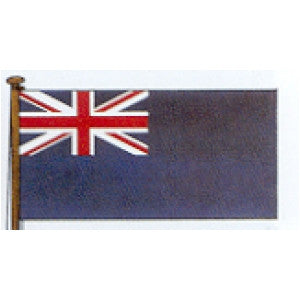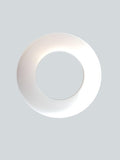Blue Ensign - Sewn
Flag Etiquette
Flag etiquette is a combination of law (what you must do) and maritime tradition (expectations of behaviour within the sea faring community).
The plain blue ensign (i.e., without any defacement or modification) is permitted to be worn, instead of the Red Ensign, by three categories of civilian vessel:
- British merchant vessels whose officers and crew include a certain number of retired Royal Navy personnel or Royal Navy reservists, or are commanded by an officer of the Royal Naval Reserve in possession of a Government warrant. The number and rank of such crew members required has varied over the years, as have the additional conditions required, since the system was first introduced in 1864.
- Royal Research Ships by warrant[a] whether manned by former Royal Navy personnel or Merchant Navy personnel.
- British-registered Yachts belonging to members of certain long-established yacht clubs, such as the Royal Thames Yacht Club, Royal Engineers Yacht Club, The Royal Motor Yacht Club, the Sussex Motor Yacht Club, and the Royal Northern & Clyde Yacht Club. Many more yacht clubs use Blue Ensigns that are defaced by badges (e.g., Royal Gibraltar Yacht Club, Royal Ulster Yacht Club, etc.).
The most senior position for a flag on a vessel is reserved for the Ensign - this is as close to the stern of the vessel as possible. The Ensign shows the country of registry of the vessel and indicates its nationality. A UK flagged vessel must wear her ensign as required by the Merchant Shipping Act, which includes when entering or leaving a foreign port and on demand. It is recommended that the ensign is worn at all times in daylight, especially when near to or in sight of land or another vessel. A UK registered vessel should wear the national maritime flag, the Red Ensign, unless entitled to wear a special Ensign. Wearing anything other than an authorised Ensign is a violation of British and International Law.
The general guideline for the size of Ensign used to be an inch per foot of yacht, but on many modern yachts this is found to be a little on the small side for the vessel to look "well dressed". Roughly speaking a:
- 3/4 yard Ensign should look right on a boat of 21-26 ft
- 1 yard for 27- 34 ft
- 1 1/4 yard for 35 - 42 ft
- 1 1/2 yard for 43 - 50 ft
- 2 yard for 51 - 60 ft
Blue Ensign - Sewn
Flag Etiquette
Flag etiquette is a combination of law (what you must do) and maritime tradition (expectations of behaviour within the sea faring community).
The plain blue ensign (i.e., without any defacement or modification) is permitted to be worn, instead of the Red Ensign, by three categories of civilian vessel:
- British merchant vessels whose officers and crew include a certain number of retired Royal Navy personnel or Royal Navy reservists, or are commanded by an officer of the Royal Naval Reserve in possession of a Government warrant. The number and rank of such crew members required has varied over the years, as have the additional conditions required, since the system was first introduced in 1864.
- Royal Research Ships by warrant[a] whether manned by former Royal Navy personnel or Merchant Navy personnel.
- British-registered Yachts belonging to members of certain long-established yacht clubs, such as the Royal Thames Yacht Club, Royal Engineers Yacht Club, The Royal Motor Yacht Club, the Sussex Motor Yacht Club, and the Royal Northern & Clyde Yacht Club. Many more yacht clubs use Blue Ensigns that are defaced by badges (e.g., Royal Gibraltar Yacht Club, Royal Ulster Yacht Club, etc.).
The most senior position for a flag on a vessel is reserved for the Ensign - this is as close to the stern of the vessel as possible. The Ensign shows the country of registry of the vessel and indicates its nationality. A UK flagged vessel must wear her ensign as required by the Merchant Shipping Act, which includes when entering or leaving a foreign port and on demand. It is recommended that the ensign is worn at all times in daylight, especially when near to or in sight of land or another vessel. A UK registered vessel should wear the national maritime flag, the Red Ensign, unless entitled to wear a special Ensign. Wearing anything other than an authorised Ensign is a violation of British and International Law.
The general guideline for the size of Ensign used to be an inch per foot of yacht, but on many modern yachts this is found to be a little on the small side for the vessel to look "well dressed". Roughly speaking a:
- 3/4 yard Ensign should look right on a boat of 21-26 ft
- 1 yard for 27- 34 ft
- 1 1/4 yard for 35 - 42 ft
- 1 1/2 yard for 43 - 50 ft
- 2 yard for 51 - 60 ft
QUESTIONS & ANSWERS
Have a Question?
Be the first to ask a question about this.


















